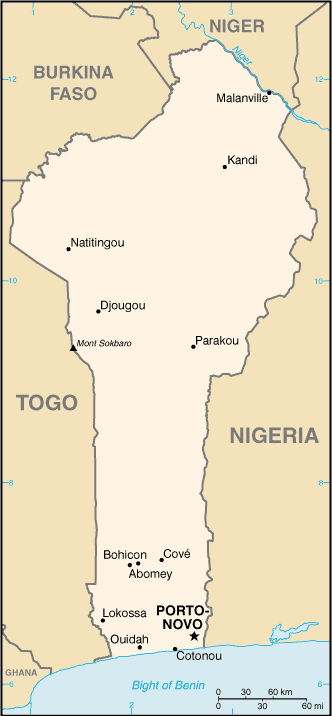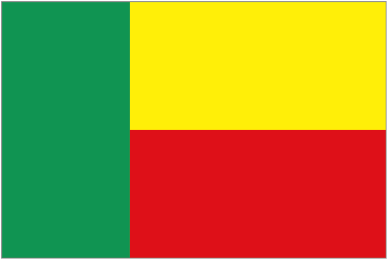- Population: 7.1 million (UN, 2005)
- Capital: Porto-Novo
- Area: 112,622 sq km (43,484 sq miles)
- Major languages: French (official) Fon, Ge, Bariba, Yoruba, Dendi
- Major religions: Indigenous beliefs, Christianity, Islam
- Life expectancy: 53 years (men), 54 years (women) (UN)
- Monetary unit: 1 CFA (Communaute Financiere Africaine) franc = 100 centimes
Backpacking in Benin
The Republic of Benin in Western Africa is easily sunk into obscurity like its flag of plain red, green, and yellow. However, credits to its club-shaped terrain, the world slowly reckons this once powerful Kingdom of Dahomey. Benin, the “Land of Songs” is one of the most stable and safest countries for travel, and definitely the most melodious in the entire West African region. Since President Yayi, a significant and near triumphant fight against corruption has strongly boosted Benin’s economic growth, with tourism as its key focus for the moment. The drive for tourism has been so strong that a huge model illustration serves as reminder of the planned tourist infrastructure developments that upon take off will readily displace the fishing villages off the Atlantic coast, despite addresses of concern about the slow coastal drop. After all, the Portuguese weren’t the only folks that landed on its shores, but also, the French, Dutch, and British traders as well.
GEOGRAPHY

Benin (9 30 N, 2 15 E) is a tiny vertical strip of 112,622 km2 territory that is eight times smaller than Nigeria. The country is mainly flat to rolling plains from the coast with spots of rocky hills and low mountains. The highest point in Benin is the Mont Sokbaro, 658 m above sea level. Coastal plains, valleys, plateaus, and low-lying mountains, evidently there is little variation in the elevation of its territory.
CLIMATE
Due to the tropical climate, Benin is almost hot and humid overall with average temperature ranges between 24o and 31oC. Benin’s dry season is from November to March, while the wet season is from April to October. The northern part of the country however could also be semiarid, and the southern to the coast, humid.
PEOPLE
The Beninese are estimated to be around 9.05 million of 42 ethnic groups as per the latest statistics with denser inhabitations to the south. The Fon and associated ethnicities are the predominant group/s in the country. Africans including immigrant populations of Nigerians, Togolese, and Malians comprise 99% of the populace while Europeans constitute a marginal population estimating to 5,500 and counting. Other minor populations of foreigners include Lebanese and Indians. Cotonou, the political and economical capital, alone has around 2 million in population. Regardless its small size, they rank 17th in birth rate with 5.4 children born to every woman. There is an average condition of AIDS with roundabout 64,000 cases of HIV-positive, which alongside effects of poverty and diseases result to the young life expectancy here.
LANGUAGE
In the former French colony, FRENCH is the official language, albeit not everyone can speak it, at least not those that matter for travellers such as cab drivers. FON is not only the dominant ethnicity but also a widely used vernacular in the south especially, as is YORUBA. In the north, the tribal languages of BARIBA, DENDI, and NAGOT are chiefly used. The people of Benin speak 51 languages, although ENGLISH is still in its infancy in the country in education or use. A restricted few can speak English, though still an inadequate number in the hospitality or tourism sects can articulate decent English.
RELIGION
Benin ought to be known as the birthplace of Voodoo, locally Vodoun, and this remains the official religion and the main influence in the lives of ordinary Beninese. Notwithstanding, Christianity remains the foremost religion of the country with more than 43% of the population as adherents of the faith, particularly Roman Catholicism and Protestantism. Islam forms almost a quarter of the populace while the remaining admits to traditional religions or none at all.
ATTRACTIONS
Casinos, hotels, restaurants, and a multitude of tourist infrastructures are in the works off the Atlantic coast of Benin. For the meantime, tourists are attracted to the untouched landscape and hordes of wildlife such as elephants, lions, hippos, and monkeys, just like the national parks of Pendjari (open December-June) and Reserve du W du Niger the to the northwest and north respectively, which are among the best in the whole of Africa and are definitely worth a visit. Atakora too is an out-of-bounds and atypical destination for a marvellous hike, as Benin’s most mountainous region, and nearby Kota Waterfalls. Porto Novo is the capital and the place to be for some local flavour with its museums and temples.
Beach-wise Grand Popo is an amazing beach fronting the Atlantic Ocean, although the strong tides and currents make this beach ideal only for powerful swimmers. Ouidha also offers watersports but some areas could be as dangerous as in Grand Popo. Ouidha is also renowned for the old Portuguese Fort. Unfortunately, like many other landmarks and structures along the coast, the ocean is slowly eating it away. Even better, join the locals and other travellers sailing or cruising in the calmer waters of Nakoue Lagoon or Lake Ganvie both in Cotonou, a great place for fresh seafood as well.
FOOD
Speaking of food, there’s an essentially diverse food in Benin starting from the base which can be bread called la pate that is typically dipped into sauces and eaten with the right hand, while some would have preferred the traditional and ever-present maize meal or a basic yam. Beans are also a significant protein source in these parts. As street grub, beans are served as a chicken-and-bean stew in almost every city. Grilled meats and seafood are also famous food fare, which is more often than not fantastic anyway. The Beninese surely know their way with grilled foodstuff, even with the little cooking mechanisms and cutlery they have that are largely self-made or customized.
Kuli-kuli is the national dish and yet is very simple. Perhaps, this fried peanut paste is the most readily available and unchallenging to prepare with minimal ingredients and basic frying involved. Peanut is also a fundamental in most Beninese sauces, as is tomato. On the whole, the flavours of Beninese cuisine is uniquely exotic which may take some minor adjusting, but healthy. Meat is expensive and scarce, hence the large servings of vegetables. And this makes sense, because in a foreign and, by and large, impoverished nation, sampling meats maybe tricky and unpleasant.





Leave A Response